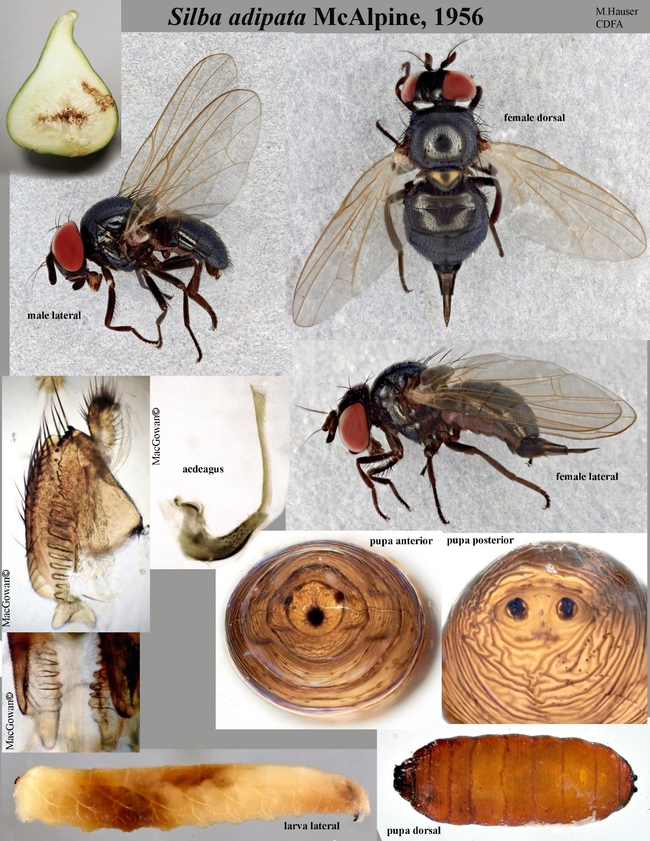The following is a pest rating proposal by Kyle Beucke (CDFA)” with some photographs by Martin Hauser (CDFA) and Iain MacGowan:
On June 10, 2021, a resident in Pasadena (Los Angeles County) submitted a fig with pupae to county agricultural personnel. The pupae were confirmed as Silba adipata with molecular techniques. On June 21, 2021, a resident in Goleta (Santa Barbara County) submitted figs with larvae to county agricultural personnel. These were also confirmed as S. adipata with molecular techniques. On June 24, 2021, a larva from a fig at the Goleta residence was collected by state (CDFA) personnel and this was confirmed as S. adipata with molecular techniques. On June 29, 2021, an adult male was confirmed as S. adipata via morphology of the genitalia. Further finds of S. adipata were made in Orange and Ventura counties. Silba adipata was not previously known to be established in the New World and it has not been rated. Therefore, a pest rating proposal is needed.
History & Status:
Background: Adult Silba adipata are black shining flies 3.5-4.5 mm in length. Adults feed on exudates of figs and fig tree sap and possibly in flowers of other plants. Edible fig (Ficus carica) is the only known larval host, and both figs and caprifigs are attacked. Female flies oviposit groups of eggs under the scales of the ostiole of the fruit, and unripe fruits are reported to be preferred for oviposition. Oviposition is reported to primarily occur on figs that are in a shaded position. Adult activity is reported to be greatest early in the morning and late in the afternoon, when temperatures are lower. Larvae feed inside the fruit, and this often results in premature fruit drop. Larvae can complete development in dropped fruit, and they emerge from emergence holes approximately 1 mm in diameter to pupate in the soil (Abbes et al., 2021; Katsoyannos, 1983; M. Hauser, pers. comm.). There are reportedly 4-6 generations per year (Katsoyannos and Guerin, 1984). Adults are active in Turkey from May to November (Tutmus, 2013).
Infestations by S. adipata caused fruit drop in Slovenia, but impact varied by location and fig variety (Rote et al., 2017). In Tunisia, it caused “massive” fruit dropand infestation rates (% of fruits infested) exceeded 80% in some cases. All varieties of figs there were reported to be susceptible (Abbes et al., 2021).
Hexanol and ammonium sulfate (use together gives three-fold increase over either alone) are attractive when used in McPhail traps (Katsoyannos and Guerin, 1984). Tutmus(2013) reported attraction of these lures to be increased greatly by the addition of fig “milk” (presumably sap).Regarding control, Abbes et al. (2021) suggested bait sprays, mass trapping, netting the fruits, and burying dropped fruit to limit development of larvae as potential control techniques. The pesticide DelegateTM250 WG is labeled for control of S. adipata on figs in South Africa (Corteva).
Worldwide Distribution: Silba adipata is reported to be native to the Mediterranean region and the Middle East. Its distribution includes: Africa: Egypt, South Africa (introduced), Tunisia; Asia: Israel, Syria, Turkey; Europe: Italy, Malta, Slovenia (introduced); North America: United States (California) (Abbes et al., 2021; D'Antonio and Fimiani, 1988; Giliomee, 2011; MacGowan and Freidberg, 2008; Mifsud et al., 2012; Rot et al., 2017; Tutmus, 2013). It was found in Morelos, Mexico in March 2020, but the status of this eradication is not known (United States Department of Agriculture).
Black Fly Damage
Black Fly Life Stages
References:
Abbes, K., Hafsi, A., Harbi, A., Mars, M., and Chermiti, B. 2021. The black fig fly Silba adipata (Diptera: Lonchaeidae) as an emerging pest in Tunisia: preliminary data on geographic distribution, bioecology and damage. Phytoparasitica. https://doi.org/10.1007/s12600-020-00871-y
Corteva. Accessed July 2, 2021: https://www.corteva.co.za/content/dam/dpagco/corteva/za/za/en/products/files/DELEGATE_ 250_WG_2020-02-05.pdf
D'Antonio, C. and Fimiani, P. 1988. Approccio ad un inventario entomofaunistico Dell'Isola di Vivara (NA). Noto preliminare. (1° contributo). Annuario del Museo Zoologico della Università di Napoli 26:155-170.
Giliomee, J. H. 2011. Recent establishment of many alien insects in South Africa –a cause for concern. African Entomology 19:151-155.
Katsoyannos, B. I. 1983. Field observations on the biology and behavior of the black fig fly Silba adipata McAlpine (Diptera, Lonchaeidae), and trapping experiments. Zeitschrift für Angewandte Entomologie 95:471-476
Katsoyannos, B. I. and Guerin, P. M. 1984. Hexanol: a potent attractant for the black fly, Silba adipata. Entomologia Experimentalis et Applicata 35:71-74.
MacGowan, I. and Freidberg, A. 2008. The Lonchaeidae (Diptera) of Israel, with descriptions of three new species. Israel Journal of Entomology 38:61-92.
Mifsud, D., Falzon, A., Malumphy, C., de Lillo, E., Vovlas, N., and Porcelli, F. 2012. On some arthropods associated with Ficus species (Moraceae) in the Maltese Islands. Bulletin of the Entomological Society of Malta 5:5-34.
Rot, M., Žežlina, I., Jancar, M., and Seljak, G. 2017. Crna figova muha (Silba adipata McAlpine, 1956 [Diptera, Lonchaeidae]) je zastopana tudi v Sloveniji. Zbornik predavanj in referatov 13:47-52.
Tutmus, E. 2013. Determination of distribution, population fluctuations and damage density of Silba adipata McAlpine (=Lonchaea aristella Becker) (Diptera: Lonchaeidae_ in fig orchards in Aydin. Master'sthesis, Adnan Menderes University, Aydin, Turkey. Accessed June 30, 2021: http://adudspace.adu.edu.tr:8080/xmlui/handle/11607/643
United States Department of Agriculture. APHIS Amends Import Requirements for Fresh Fig (Ficus carica) Fruit from Mexico. Accessed June 29, 2021: https://www.aphis.usda.gov/import_export/plants/plant_imports/federal_order/downloads/2 020/DA-2020-19.pdf
READ the CDFA Alert: https://blogs.cdfa.ca.gov/Section3162/wp-content/uploads/2021/07/Silba-adipata.pdf

